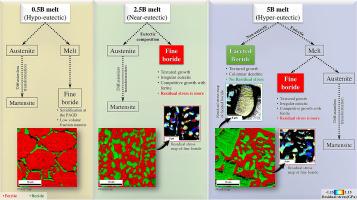硼化物-铁素体复合材料中的非共晶与共晶硼化物:微化学、显微组织和残余应力的差异
IF 2.9
Q2 MATERIALS SCIENCE, MULTIDISCIPLINARY
引用次数: 0
摘要
本研究的对象是经过热处理的铸态含硼9Cr-1Mo钢,这导致了bcc-铁素体(α-Fe)和硼化物((Fe,Cr)2B)相的各种复合材料。热处理,正火和回火,是必要的,以减少复合材料脆化。然而,它们并没有显著改变相特异性的微化学、显微组织和残余应力。硼含量的增加(0.5 wt%和2.5 wt%至5 wt%)如预期的那样增强了硼化物的存在。在下部含硼试样中,观察到细小(~ 1 μm)的凝固后共晶硼化物。另一方面,含硼量为5 wt%的材料含有较大(~ 23 μm)的非共晶硼化物和较小(~ 1 μm)的共晶硼化物,它们的体积分数几乎相等。因此,硼含量的增加将具有陶瓷增强(0.5 wt%和2.5 wt%硼)的金属基复合材料转变为具有金属第二相(5 wt%硼)的陶瓷基复合材料。本研究广泛使用分析显微镜,特别是基于多尺度衍射的显微组织和残余应力测量,来区分共晶和非共晶硼化物。非共晶硼化物具有典型定向凝固的形态排列。他们还展示了面和非面界面,前者代表了更清晰的构图梯度。此外,非共晶硼化物表现出更强的晶体织构、更低的晶粒内取向偏差、取向梯度和更低的残余应力。非共晶硼化物在初始凝固阶段以初生枝晶形式产生。而在枝晶间枝上则形成共晶硼化物和铁素体。非共晶硼化物的生长选择和枝晶边界的背应力松弛似乎决定了陶瓷基复合材料相特异性显微组织的差异。本文章由计算机程序翻译,如有差异,请以英文原文为准。

Non-eutectic versus eutectic borides in a boride-ferrite composite: Differences in microchemistry, microtexture, and residual stress
This study involved as-cast, albeit heat-treated, boron-containing 9Cr-1Mo steel, which resulted in various composites of bcc-ferrite (α-Fe) and boride ((Fe,Cr)2B) phases. The heat treatments, normalizing and tempering, were necessary to reduce composite embrittlement. However, they did not significantly alter phase-specific microchemistry, microtexture, and residual stress. An increase in boron content (0.5 and 2.5 to 5 wt%) enhanced, as expected, boride presence. In the lower boron-containing specimens, fine (∼1 μm) post-solidification eutectic borides were observed. Material with 5 wt% boron, on the other hand, contained larger (∼23 μm) non-eutectic and smaller (∼1 μm) eutectic borides in almost equal volume fractions. An increase in boron content thus transformed a metal-matrix composite with ceramic reinforcement (0.5 and 2.5 wt% boron) into a ceramic-matrix composite with a metallic second phase (5 wt% boron). This study extensively used analytical microscopy, particularly multiscale diffraction-based microtexture and residual stress measurements, to differentiate between eutectic and non-eutectic borides. The non-eutectic borides had a morphological alignment typical of directional solidification. They also exhibited faceted and non-faceted interfaces, the former representing a sharper composition gradient. Further, the non-eutectic borides showed stronger crystallographic texture, lower in-grain misorientations, orientation gradients, and significantly lower residual stresses. The non-eutectic borides appeared to originate as primary dendrites during the initial solidification stages. In contrast, eutectic borides and ferrites formed subsequently in the interdendritic arms. Growth selection of the non-eutectic borides and back-stress relaxation at the dendrite boundaries appeared to define the differences in phase-specific microstructures of the ceramic-matrix composite.
求助全文
通过发布文献求助,成功后即可免费获取论文全文。
去求助
来源期刊

Materialia
MATERIALS SCIENCE, MULTIDISCIPLINARY-
CiteScore
6.40
自引率
2.90%
发文量
345
审稿时长
36 days
期刊介绍:
Materialia is a multidisciplinary journal of materials science and engineering that publishes original peer-reviewed research articles. Articles in Materialia advance the understanding of the relationship between processing, structure, property, and function of materials.
Materialia publishes full-length research articles, review articles, and letters (short communications). In addition to receiving direct submissions, Materialia also accepts transfers from Acta Materialia, Inc. partner journals. Materialia offers authors the choice to publish on an open access model (with author fee), or on a subscription model (with no author fee).
 求助内容:
求助内容: 应助结果提醒方式:
应助结果提醒方式:


